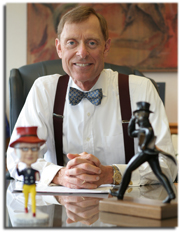Farley celebrates 10 years of change
May 6, 2007
A man with a drive, a bevy of supporters and one decade: that’s what it has taken to start the dramatic changes Washburn has seen in such a short period of time.
Jerry Farley, university president, is a modest man with big plans for the university. If asked, he’ll say it isn’t so much about him being here as it is the university working as a whole to achieve the dramatic changes that have occurred. Ten years ago, Farley set foot on a campus that was two-thirds non-traditional, part-time students, and in only a few years managed to flip the campus demographics a complete 180 degrees. The change was huge, said Farley.
With a goal to leave a legacy for Washburn, not himself, Farley, along with the cooperation of faculty and administrators on campus, has managed to start a momentous growth process for Washburn that began with the building of the Living Learning Center. Cited as the first major anchor towards reviving student life on campus, Farley said once people saw it was possible to do things like that on campus, everything began to snowball, leading to construction of the new art building, Washburn Village, the Student Recreation and Wellness Center and the current renovation of Stoffer Science Hall.
“Once we had a few successes, then I think it just unleashed this enthusiasm across the campus,” said Farley.
Prior to construction of the LLC, there had been a movement on campus to build student housing for about a decade, but it never succeeded because things just never came together. Also, the most money raised for a new project was $2 million for the Bradbury Thompson Alumni Center. The main reason Farley believed much hadn’t been accomplished in the past was simply because there was not enough faith in the process, saying many people like to see visible change before they will believe it.
“You won’t see anything happen until you believe it will happen,” said Farley.
The next step for Washburn isn’t completely clear, but Farley believed he had a good idea of where the university will go from here. Over the next decade, he predicted Washburn will continue to grow steadily, and that new buildings along with rising enrollment will naturally plateau in about seven years. The biggest change that awaits Washburn is going to be the cooperation between the university and Kaw Area Technical School, which will allow for students seeking a technical education a smoother transition into a four-year degree program if they choose to seek that route. Another goal Farley had for students was to create a more fluid transition from the learning environment to the work force, through greater cooperation with Topeka businesses. His ultimate goal is to make the change from being a student, going to an internship and finally holding a full-time job as seamless as possible.
Farley believes the changes that have been and will be made at Washburn can only be accomplished through constant and consistent leadership, and that he plans to be at Washburn to see what could happen in the next decade.



